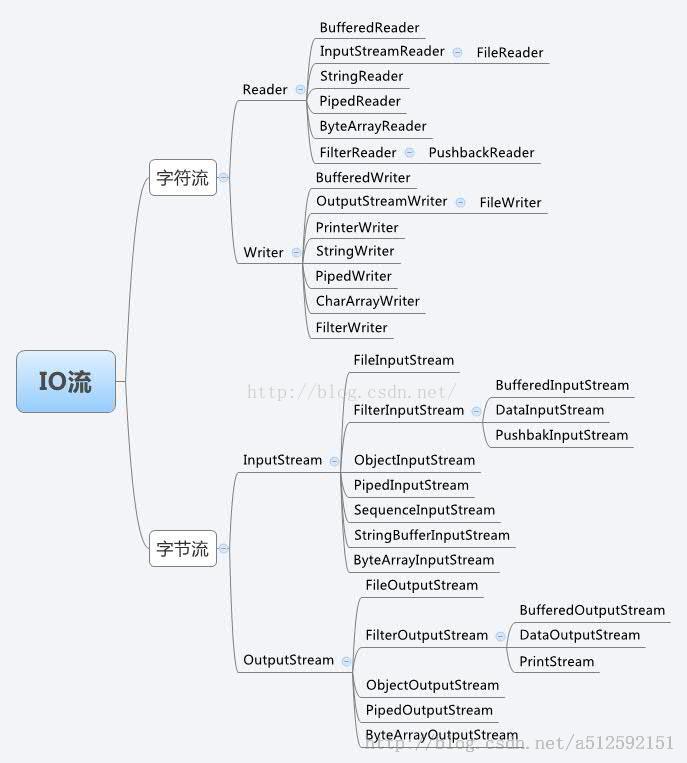Java中文件流的两个主要方式就是字符流和字节流,如下图:

具体的使用方法可以参考官方文档,这里主要介绍四种常见的文件读取方式
1.通过字节来读取文件(常用于二进制文件:图片、声音、视频等)
2.通过字符来读取文件(常用于文本的读取)
3.通过行来读取文件(常用于面向行的格式化文本读取)
4.随机读取文件(基于字节来读取)
下面是对于这四种读取方式的代码,如下:
|
1
2
3
4
5
6
7
8
9
10
11
12
13
14
15
16
17
18
19
20
21
22
23
24
25
26
27
28
29
30
31
32
33
34
35
36
37
38
39
40
41
42
43
44
45
46
47
48
49
50
51
52
53
54
55
56
57
58
59
60
61
62
63
64
65
66
67
68
69
70
71
72
73
74
75
76
77
78
79
80
81
82
83
84
85
86
87
88
89
90
91
92
93
94
95
96
97
98
99
100
101
102
103
104
105
106
107
108
109
110
111
112
113
114
115
116
117
118
119
120
121
122
123
124
125
126
127
128
129
130
131
132
133
134
135
136
137
138
139
140
141
142
143
144
145
146
147
148
149
150
151
152
153
154
155
156
157
158
159
160
161
162
163
164
165
166
167
168
169
170
171
172
173
174
175
176
177
|
package com.ds.io; //1、按字节读取文件内容 //2、按字符读取文件内容 //3、按行读取文件内容 //4、随机读取文件内容 import java.io.BufferedReader; import java.io.File; import java.io.FileInputStream; import java.io.FileReader; import java.io.IOException; import java.io.InputStream; import java.io.InputStreamReader; import java.io.RandomAccessFile; import java.io.Reader; public class ReadFromFile { /** * 以字节为单位读取文件,常用于读二进制文件,如图片、声音、影像等文件。 * @param fileName 文件的名 */ public static void readFileByBytes(String fileName) { File file = new File(fileName); InputStream in = null; try { System.out.println("以字节为单位读取文件内容,一次读多个字节:"); // 一次读多个字节 byte[] tempbytes = new byte[100]; int byteread = 0; in = new FileInputStream(fileName); ReadFromFile.showAvailableBytes(in); // 读入多个字节到字节数组中,byteread为一次读入的字节数 while ((byteread = in.read(tempbytes)) != -1) { System.out.write(tempbytes, 0, byteread); } } catch (Exception e1) { e1.printStackTrace(); } finally { if (in != null) { try { in.close(); } catch (IOException e1) { } } } } /** * 以字符为单位读取文件,常用于读文本,数字等类型的文件 * @param fileName 文件名 */ public static void readFileByChars(String fileName) { File file = new File(fileName); Reader reader = null; try { System.out.println("以字符为单位读取文件内容,一次读多个字节:"); // 一次读多个字符 char[] tempchars = new char[30]; int charread = 0; reader = new InputStreamReader(new FileInputStream(fileName)); // 读入多个字符到字符数组中,charread为一次读取字符数 while ((charread = reader.read(tempchars)) != -1) { // 对于windows下,rn这两个字符在一起时,表示一个换行。 // 但如果这两个字符分开显示时,会换两次行。 // 因此,屏蔽掉r,或者屏蔽n。否则,将会多出很多空行。 if ((charread == tempchars.length) && (tempchars[tempchars.length - 1] != 'r')) { System.out.print(tempchars); } else { for (int i = 0; i < charread; i++) { if (tempchars[i] == 'r') { continue; } else { System.out.print(tempchars[i]); } } } } } catch (Exception e1) { e1.printStackTrace(); } finally { if (reader != null) { try { reader.close(); } catch (IOException e1) { } } } } /** * 以行为单位读取文件,常用于读面向行的格式化文件 * @param fileName 文件名 */ public static void readFileByLines(String fileName) { File file = new File(fileName); BufferedReader reader = null; try { System.out.println("以行为单位读取文件内容,一次读一整行:"); reader = new BufferedReader(new FileReader(file)); String tempString = null; int line = 1; // 一次读入一行,直到读入null为文件结束 while ((tempString = reader.readLine()) != null) { // 显示行号 System.out.println("line " + line + ": " + tempString); line++; } reader.close(); } catch (IOException e) { e.printStackTrace(); } finally { if (reader != null) { try { reader.close(); } catch (IOException e1) { } } } } /** * 随机读取文件内容 * @param fileName 文件名 */ public static void readFileByRandomAccess(String fileName) { RandomAccessFile randomFile = null; try { System.out.println("随机读取一段文件内容:"); // 打开一个随机访问文件流,按只读方式 randomFile = new RandomAccessFile(fileName, "r"); // 文件长度,字节数 long fileLength = randomFile.length(); // 读文件的起始位置 int beginIndex = (fileLength > 4) ? 4 : 0; // 将读文件的开始位置移到beginIndex位置。 randomFile.seek(beginIndex);//以字节数来设置偏移量 byte[] bytes = new byte[10]; int byteread = 0; // 一次读10个字节,如果文件内容不足10个字节,则读剩下的字节。 // 将一次读取的字节数赋给byteread while ((byteread = randomFile.read(bytes)) != -1) { System.out.write(bytes, 0, byteread); } } catch (IOException e) { e.printStackTrace(); } finally { if (randomFile != null) { try { randomFile.close(); } catch (IOException e1) { } } } } /** * 显示输入流中还剩的字节数 * @param in */ private static void showAvailableBytes(InputStream in) { try { System.out.println("当前字节输入流中的字节数为:" + in.available()); } catch (IOException e) { e.printStackTrace(); } } public static void main(String[] args) { String fileName = "C:\\Users\\Administrator\\Desktop\\客户问题20160214.txt"; ReadFromFile.readFileByBytes(fileName); ReadFromFile.readFileByChars(fileName); ReadFromFile.readFileByLines(fileName); ReadFromFile.readFileByRandomAccess(fileName); } } |
以上就是java IOl流的操作,如有疑问可以留言或者到本站社区交流,感谢阅读,希望能帮助到大家,谢谢大家对本站的支持!
原文链接:http://blog.csdn.net/u013755987/article/details/50682783















